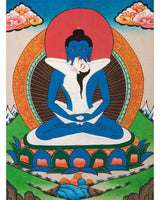
Bodhisattva Samantabhadra Buddha | Yab Yum Samantabhadra Buddha | Religious Wall Decor

100% AUTHENTIC

HANDMADE

FREE SHIPPING
Bodhisattva Samantabhadra Buddha
About Our Thangka :
Our thangka is a beautiful hand painting of Samantabhadra with his consort. It is finely detailed with natural stone color and 24K gold. In the thangka, Samantabhadra can be seen seated on the lotus throne in vajra posture.
Introduction To Samantabhadra :
Samantabhadra Buddha and Samantabhadra the Bodhisattva are unrelated and not the same subject or entity. The first is a special buddha unique to the Nyingma Tantric Tradition. The second is a bodhisattva that arises from the Mahayana Sutra literature.
Samantabhadra Buddha arises from the early Nyingma Tantric literature of the Guhyagarbha Tantra and others. He is usually blue-black in color, naked, and has Buddha Appearance (though this is not always the case), with hands in meditation gestures and legs in a vajra stance. He embraces Samantabhadri, his consort. She is light-skinned and naked. In some textual traditions, the two are depicted with clothing and jewelry.
A second way that Samantabhadra can be depicted is as the group of Five Buddhas of the Guhyagarbha Tantra. The five are the same Five Buddhas of the ‘New’ Tantra Traditions however there are slight variations in the details of their appearance, color, gestures, consort, etc.
According to traditional Tibetan Buddhism Buddha Samantabhadra is the primordial Buddha and the central figure of the most important of all Tantras: the Guhyagarbha Tantra.
In the verses of the Nyingma texts Samantabhadra is described as the “primordial Lord of unchanging light, the central origin of all mandalas, possessing the ocean of knowledge and pristine awareness”.
------------------------------------------------------------------
Size: 8"/ 20 cm (width) x 11"/ 28 cm (height)
Materials: Cotton Canvas, Acrylic Colors, Genuine 24K Gold
------------------------------------------------------------------
THIS THANGKA IS HAND-PAINTED IN THE TRADITIONAL STYLE AND THE QUALITY IS HIGH
How can Thangka benefit us?
Thangkas, which were formerly utilized as teaching aids, are now used as a meditation technique to assist in moving one closer to enlightenment. During rituals and ceremonies, devotional images serve as the focal point and frequently serve as a conduit for prayers and requests.
Shipping & Returns
We ship worldwide. Orders dispatch in 2–3 business days. International delivery typically arrives in 4–10 business days via DHL Express, depending on destination and carrier conditions. All items ship free globally.
Returns are accepted within 14 days of delivery. Products must be returned in original condition for a refund to be issued once received and inspected. Terms and conditions apply.











